List of members |
Facilities |
Internships and jobs |
PhD |
Publications |
News |
Team
- Permanent Membres: Laurent Belliard, Olga Boyko, Agnès Huynh, Eric Charron, Serge Vincent
- Guest Researcher: Bernard Perrin
- PhD Student:
Phonons play an essential role in the optical and electronic phenomena of semiconductors and their nanostructures. In particular, terahertz acoustic phonons are directly involved in the relaxation of carriers confined in nanostructures such as quantum wells or quantum boxes. Just as the structuring of matter at the micrometer scale allows to obtain particular optical properties, a structuring at the nanometer scale allows a control of the acoustic properties in the THz range. In particular, we have studied GaAs/AlAs superlattices as a nanocavity element for phonon confinement or as a sub-THz phonon generator or detector.
- Acoustic attenuation in semiconductors
- Acoustic attenuation in glass
- Elastic containment
- Elasticity of biological systems
- Multi-functional materials
- Experimental studies on elastic waves in nanomaterials and structure
- Non-destructive testing of the opto-mechanical properties of piezoelectric nanowires
- Publications
Acoustic attenuation in semiconductors
- Agnès Huynh
- Bernard Perrin
Collaborations
- Jelena Sjakste, Nathalie Vast : Laboratoire des Solides Irradiés (LSI), École Polytechnique–CEA/DRF/IRAMIS–CNRS UMR 7642, Palaiseau
- Lorenzo Paulatto : Institut de Minéralogie, de Physique des Matériaux et de Cosmochimie (IMPMC), Sorbonne Université
We are interested in the attenuation of high frequency sound waves. This is a hot topic as electronic systems operate at increasingly higher frequencies. Moreover, high-frequency sound attenuation is related to heat propagation which plays an important role in many technological problems. The knowledge of high frequency attenuation is also important for the development of imaging by acoustic techniques of buried microstructures in the field of microelectronics, and thus in standard semiconductor materials (GaAs, Si for example). Finally, the development of optomechanics towards higher and higher resonator frequencies, the tens of gigahertz, comes up against the limitation of the quality factor by the phonon-phonon interactions when the temperature increases.
We thus study the propagation of sub-terahertz frequency acoustic waves in various materials (GaAs, silicon) and generated and detected using optical-acoustic transducers such as GaAs/AlAs superlattices and/or metallic films excited by femtosecond laser pulses in a pump-probe configuration.
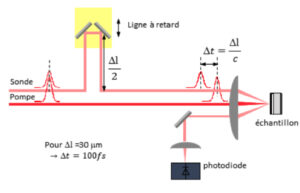
Caption: Principle of the picosecond acoustic pump-probe experiment.
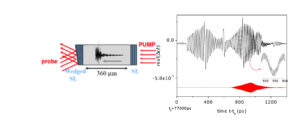
Caption:T=15K. A superlattice (SL) of 5nm period excited by a laser pulse generates a wave train composed of a low frequency continuum (f<100GHz) and a 1THz component. This acoustic wave train propagates in the GaAs substrate and is detected by the change of reflection of the probe pulse on another superlattice of well-chosen period (~5nm). The obtained signal contains essentially 2 frequencies, the Brillouin frequency at 45GHz and the 1THz frequency (see the oscillations in the enlargement, of period 1ps, and in red the filtered signal around 1THz). This configuration allowed to measure the acoustic attenuation at 1THz by following the evolution of the amplitude of the signal at this frequency as a function of temperature.
- Agnes Huynh
- Bernard Perrin
Collaborations
- Marie Forêt, Laboratoire Charles Coulomb université de Montpellier
- Lafosse et A. Lemaître, C2N, Paris Saclay
- K. Sun, Université de Taiwan
Lenses have many elastic anomalies such as, for example, a compressibility that increases with increasing pressure: the structure “softens” under high pressure. The origin of these peculiarities is to be sought in order at medium distance. We are interested in the propagation of acoustic waves at frequencies ranging from a few hundred GHz to THz, i.e. for acoustic wavelengths close to the characteristic lengths of expected structural and vibrational inhomogeneities. Moreover, an almost universal property of glass is the existence of an excess of modes whose maximum state density is around THz: the Boson peak. Acoustic modes lose their plane wave character at frequencies above a limit defined by an Ioffe Regel criterion. This threshold must be the consequence of a strong damping mechanism preponderant for these frequencies (0.1-1THz), the origin of which is still debated.
We are therefore interested in measuring the velocity and attenuation of acoustic waves as a function of temperature and frequency in a model glass, silica. We study the propagation of acoustic impulses in silica films in various configurations.
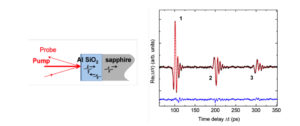
Caption: Successive acoustic echoes reflected on the silica/substrate interface. An analytical model is used to adjust the curves in order to deduce the attenuation (in red).
- Laurent Belliard
- Bernard Perrin
- Eric Charron
- Serge Vincent
- Ronan Delalande
Collaborations
- IM2NP in Marseille
- INAC CEA in Grenoble
- GSI Helmholtz in Darmstadt
- Max Plank Inst. in Stuttgart
From a general point of view, the elasticity of nano-objects is of great interest to the scientific community. Indeed, many questions remain unanswered, such as for example, the limit of validity in size of the continuous medium hypothesis, the role of internal stress fields, what is the impact of structuring processes on the mechanical response of these entities and more particularly on life times?
We address these issues on a model system: the single nanowire.
The elastic parameters are accessible through the analysis of the different resonance modes of these objects, but the spectral fineness of the vibrational dynamics must be sufficiently good. In order to exacerbate the confinement, we are working on self-sustaining systems thanks to the pre-structuring of the substrates.
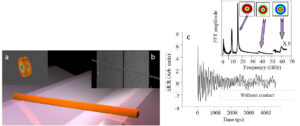
Caption: a) Animation of the main breathing mode detected. b) A Cu nanowire self-suspended over a trench on Si. c) Temporal and spectral response of a single nanowire.
Elasticity of biological systems
- Laurent Belliard
- Eric Charron
- Serge Vincent
Collaborations
- LCMCP SU
- SPPIN UP
- Centre de recherche ECE
The regeneration of neurons under an electric field is a vector of immense hopes for the treatment of pathologies and/or severe traumas of the central and/or peripheral nervous system. As cell migration and differentiation are very strongly linked to the elastic environment, elastic characterizations at the micron scale are of paramount importance in this context. On the other hand, the link between elasticity and cancer pathology has been demonstrated, thus opening the way to the quantitative study of the effect of certain treatments.
The approach envisaged for extracting elasticity from biological objects (collagen films, PC12, motor neurons) is based on a pump-probe optical approach, namely picosecond acoustic imaging (IAP), which allows to map the properties of adhesion, elasticity and viscosity at the scale of cell inhomogeneities.
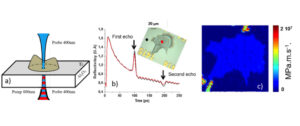
Caption: a) Experimental geometry. b) Comparison between a time response with and without motor neuron. c) Acoustic impedance mapping at the cell level.
- Laurent Belliard
- Bernard Perrin
- Eric Charron
- Serge Vincent
- Ronan Delalande
Collaborations :
- LSPM of Paris XIII
- Institut P’ of Poitiers
- IMR in China, Department of Solid State Sciences, Ghent University
The industry’s strong need for coatings with high wear and/or corrosion resistance has stimulated a great deal of research in the field of materials in order to synthesize layers with adequate hardness and tribological properties. In this perspective, metastable solid solutions based on ternary and quaternary nitride alloys such as AlCrN, TiZrN, TiTaN and alloys with high entropy are excellent candidates. Our time-resolved approaches coupled with spontaneous Brillouin surface diffusion techniques have demonstrated their strength in addressing the correlations between elastic property and microstructure in such systems.
The valorization aspect of our experimental approaches to industrial issues is also important. Examples include collaborations with the Saint Gobain research center, CEA-LETI, Essilor, CEA-Ripaud and the start-up Néta.
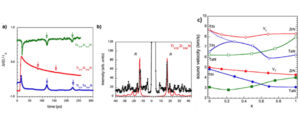
Caption: a) Time spectrum illustrating longitudinal echo detection. b) Brillouin scattering spectrum. c) Evolution of Vl and Vt in ternary alloys.
Experimental studies on elastic waves in nanomaterials and structure
- Olga Boyko
- Eric Charron
Collaborations
- Centre de Nanosciences et de Nanotechnologies – C2N (France)
- Institute of Mechanics, Mathematics and Informatics, Kuban State University, Krasnodar (Russia)
- Grope of Nanophotonic Devices, DTU Fotonik – Technical University of Denmark, Department of Photonic Engineering (Denmark)
We focus our study on the elastic behavior of advanced materials that are made using clean room technology. We have both an experimental and numerical approach to study the generation of high-frequency elastic waves, the interaction between the wave and matter, and the control of wave propagation at the micro and nanometer scales. The engineering materials we design are composed of inclusions in a solid matrix. These materials have unique and exotic propagation properties. We are working on the generation of ultrasonic surface acoustic waves (SAW) in structures based on nitride nanowires which are promising materials for micro-piezoelectric generators and energy harvesting. A non-invasive technique, the transient grating method, is used to generate and analyze acoustic wave propagation in the frequency range from a few tens of MHz to several GHz. Wave propagation is simulated using a time-efficient computer model based on explicit integral and asymptotic representations of laser-generated surface acoustic waves in layered anisotropic waveguides. The effective parameters of the multilayer model are obtained by minimizing the difference between the measured and calculated wave characteristics.
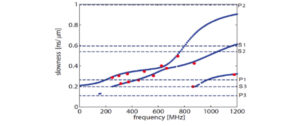
Caption: Reconstruction of the elastic behavior of the GaN composite material with optimization algorithm.
Non-destructive testing of the opto-mechanical properties of piezoelectric nanowires
- Olga Boyko
- Eric Charron
This project focuses on the realization of interdigital transducers (IDTs) to generate high-frequency acoustic waves in piezoelectric nano-objects for their non-destructive testing.
Interdigital surface wave transducers are generally obtained by depositing a pattern of electrodes on a piezoelectric plate allowing the direct generation and detection of surface waves on the same plate. This concept has been widely used in the field of electronics as a signal processing device because Rayleigh waves can be excited very efficiently on this type of structure even at high frequencies of several GHz. This type of sensor combines, on the same piezoelectric plate, the electrodes for the generation of surface waves and the electrodes for their detection.
We adapt the technique to the study of the mechanical properties of piezoelectric nanowires made of galium nitrite. In the scientific literature, we find a large number of papers exploiting the remarkable optoelectronic properties of GaN nanowires resulting in part from their high aspect ratio. They are mechanically flexible and can withstand strong deformations without plastic relaxation. Thanks to this performance, a large number of books are devoted to the study of composite materials containing nanowires and, independently, to the study of the properties of a single nanowire. In particular, nanowires integrated in a polymer matrix offer an elegant solution to create a flexible piezo-generating material that converts environmental energy into electrical energy.
A great deal of work is devoted to the study of optoelectronic properties; there has been little research on the elastic properties of nanowires. Some research focuses on the study of the conversion of mechano-electric energy in the Hz and kHz range. Most environmental vibrations cover a frequency spectrum at the kHz scale, and the transformation of ambient noise at kHz into electrical energy is a means of creating piezoelectric micro-devices useful in our daily lives. However, due to the nanoscale size, mechanical resonances of nanowires are expected at frequencies ranging from a few hundred MHz to several GHz.
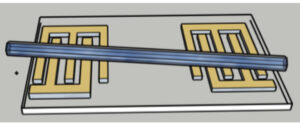
Caption:The GaN nanowire is placed on interdigital transducers. The generation field of the array penetrates the nanowire and creates an elastic stress that propagates to the sensing array.
In our experiment, Rayleigh waves will be generated directly in the GaN material and not on the surface of the substrate itself. The project is therefore essentially experimental. It is based on the instrumental means at our disposal in the laboratory: “clean room” technologies, excitation and detection of elastic waves by IDT, manipulation of nano-objects.
PHYSICAL REVIEW B 93, 184304 (2016)
PHYSICAL REVIEW B 95, 014304 (2017)
Huynh et al PHYSICAL REVIEW B 96, 174206 (2017)
- Probing elastic properties of nanowire-based structures. Applied Physics Letters 113 (16), 161903 (2018) https://hal.sorbonne-universite.fr/hal-01913851
- O. Boyko, E. Charron, B. Bonello, L. Lu, M. Tchernycheva, N. Gogneau, E. Glushkov, N. Glushkova. High Frequency Elastic Properties of Nitride Nanowires-Based Structures. Journal of Physics: Conference Series 1092, 012014 (2018) https://hal.archives-ouvertes.fr/hal-02385637
- E. Glushkov, N. Glushkova, O. Boyko. An analytically based computer model for evaluating effective elastic properties of nitride nanowire-polymer compositions using laser-generated surface acoustic waves. JPhCS 1092 (1), 012042 (2018) https://iopscience.iop.org/article/10.1088/1742-6596/1092/1/012042
- Evaluation of Effective Elastic Properties of Nitride NWs/Polymer Composite Materials Using Laser-Generated Surface Acoustic Waves. Applied Sciences 8 (11), 2319 (2018) https://hal.sorbonne-universite.fr/hal-01954341
- E. Glushkov, N. Glushkova, A. Eremin, O. Boyko. Determination of effective parameters of composite materials using surface acoustic waves. Proceedings of Meetings on Acoustics ICU 38 (1), 045017 (2019) https://asa.scitation.org/doi/abs/10.1121/2.0001096
- Large influence of vacancies on the elastic constants of cubic epitaxial tantalum nitride layers grown by reactive magnetron sputtering. Acta Materiala 24, 254-266 (2020) https://hal.archives-ouvertes.fr/hal-02470856/
- S. Fernández, C. Jean, E. Charron, P. Gentile, M.I. Richard, O. Thomas, B. Perrin, L. Belliard. In depth characterization of Ge-Si core-shell nanowires using X-ray coherent diffraction and time resolved pump-probe spectroscopy. Jour. Appl. Phys. 126, 204304 (2019) https://hal.archives-ouvertes.fr/hal-02457440
- A. Viel, E. Péronne, O. Sénépart, L. Becerra, C. Legay, F. Semprez, L. Trichet, T. Coradin, A. Hamraoui, L. Belliard. Picosecond ultrasounds as elasticity probes in neuron-like cells models. Appl. Phys. Lett. 115, 213701 (2019) https://hal.archives-ouvertes.fr/hal-02457446
- G.Abadias, J.J.Colin, D.Tingaud, Ph.Djemia, L.Belliard, C.Tromas. Elastic properties of α- and β-tantalum thin films. Thin. Sol. Films 688, 137403 (2019) https://hal.archives-ouvertes.fr/hal-02457454
- R. Delalande, L. Burr, E. Charron, M. Jouini, M. E. Toimil-Molares, L. Belliard. Vibrational response of Au-Ag alloy and porous Au single nanowires probed by ultrafast pump-probe spectroscopy, Appl. Phys. Lett. 115 083103 (2019) https://hal.archives-ouvertes.fr/hal-02134035v2
- B. Zhao, F. Xu, L.Belliard, H. Huang, B. Perrin, P. Djemia, A. Zerr. Sound Velocities and Elastic Moduli of Phases I and V of Silicon at High Pressures. Phy. Sta. Sol. Rap. Res. Lett . 13 (8) (2019) https://hal.archives-ouvertes.fr/hal-02470850
- E. Alonso-Redondo, L. Belliard, K.Rolle, B. Graczykowski, W. Tremel, B. Djafari-Rouhani, G. Fytas; Robustness of elastic properties in polymer nanocomposite films examined over the full volume fraction range. Scientific Reports (8), 16986 (2018) https://hal.archives-ouvertes.fr/hal-02457460
- N. Tureson, M. Marteau, T. Cabioch, N.V Nong, J. Jensen, J. Lu, G. Greczynski, D. Fournier, N. Singh, Ajay Soni, L. Belliard, P. Eklund, A. le Febvrier. Effect of ion-implantation-induced defects and Mg dopants on the thermoelectric properties of ScN. Phys. Rev. B 98, 205307 (2018) https://tel.archives-ouvertes.fr/INSP/hal-02457458v1
- F. Faese, D. Poinot, P. Djemia, S. Chatel, L. Belliard. Mechanical properties of elementary layers involved in a multilayer optical stack by photon-acoustic phonon interaction approaches. Jour. Appl. Phys. 124, 125307 (2018) https://hal.sorbonne-universite.fr/hal-01922024F
- P.A. Mante, L. Belliard, B. Perrin. Acoustic phonons in nanowires probed by ultrafast pump-probe spectroscopy. Nanophotonics 7 (11) 1759–1780 (2018) https://hal.archives-ouvertes.fr/hal-02457473
- Reactive sputter deposition of CoCrCuFeNi in nitrogen/argon mixtures. Journal of Alloys and Compounds 769, 881-888 (2018) https://hal.archives-ouvertes.fr/hal-02095949
- M. Gharavi, S. Kerdsongpanya, S. Schmidt, F. Eriksson, N. Ngo Van, J. Lu, B. Balke, D. Fournier, L. Belliard, A. Le Febvrier, C. Pallier, P. Eklund. Microstructure and thermoelectric properties of CrN and CrN/Cr2N thin films. JPhysD (2018) 116465.R2 https://hal.archives-ouvertes.fr/hal-02457466

